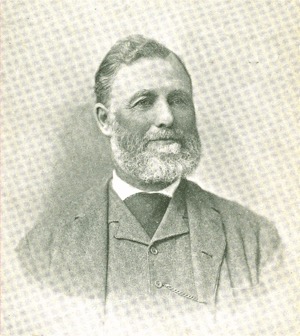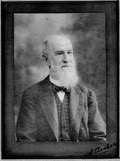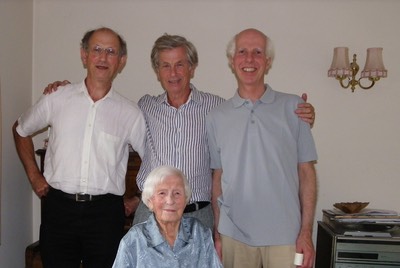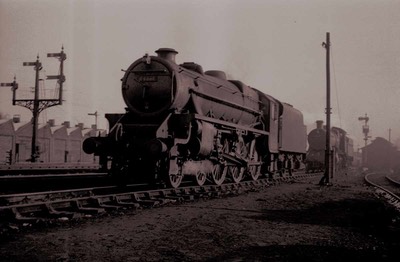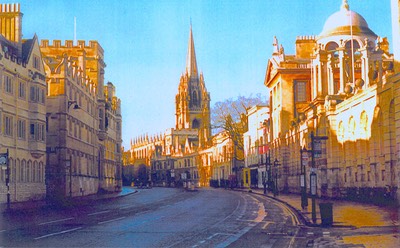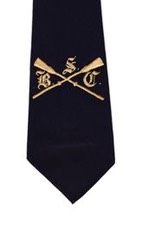The Oxford City Locomotive Club (1940s and 1950s):
Not a very cohesive club, as I recollect it. Meetings were at the (so it seems now, but it did not then) unlikely and august venue of Manchester College, Mansfield Road, Oxford (click here for photo-see lower one on page) courtesy of the Principal, Dr Garrard I believe, who was (I now know, courtesy of his son Tony, but had no idea then) likewise a rail enthusiast. The club officers included Michael Crewe (Crew?), who lived in Headley Way, Headington (just down Woodlands Road from us at 17 Sandfield Road), and Tony Doyle, who now lives at Radley and is a member of a group called The Friends of Radley Station, not to mention being a member of “RCTS” (the Railway Correspondence and Travel Society). Via Tony Garrard and my Unitarian friend Rev Peter Hewis, who lives at Yarnton, I now have (but not to hand to post on this site just now[**]) a very memorable photo (click here) of the Oxford Trainspotters (what was our official name, I wonder?) on one of our outings to railway sheds organised by Michael Crew. [**]now added:28.11.14.
(Updated 4.1.2015): I have now found online an article from the Oxford Mail in 2013 all about our club and providing much background information - click here for the text of the article. And here is a link (click here) to the Oxford Mail article itself - from which I now realize I should call the club “The Oxford City Locomotive Club” (correction above from ‘Oxford Trainspotters’ now made) and the photo above (“a very memorable photo” etc) is actually: “Members of the Oxford City Locomotive Club visiting March (**) motive power depot in Cambridgeshire in May 1957”. So I am out by three years in terms of my estimated age and (therefore) the date, in my notes on the photo. Likewise I had completely forgotten visiting March, and little thought then that I would spend more than 20 years of my working life running an office not far away in Peterborough. Equally, I was completely unaware of the “chance meeting at the Port Meadow gate, just north of Oxford station, between the Rev L.A. Garrard, principal of Manchester College, and Michael Crew, a pupil at Oxford High School for Boys", which led to the formation of the club. That “Port Meadow gate” was what I called ‘Walton Well Road’, at the Walton Well Road railway bridge, where a cinders cycle track through the Oxford engine shed (‘Motive Power Depot’) ran from near the railway bridge, southwards through the engine shed, and emerged near the end of Cripley Road, at the main entrance (for staff) to the engine shed, beside a link from the Thames River (which runs alongside the shed, towards Port Meadow) to the Oxford Canal - a place of truly ‘Industrial Revolution’ connections with the 19th century. Click here for a photo gallery of steam from my ‘locomotive club days’ and later, including one shot (found online) from the Walton Well Road bridge showing that “Port Meadow Gate”. Some at least of these shots were taken on Oxford Locomotive Club trips organised by Michael Crew. (**) So, I actually was in March in 1957 where my grandfather (WGRA)’s sister Kate lived her married life, and may have still been living there then, though I knew it not.
(Added 13.9.14): a wonderful website of text and graphics going back to railways in the 1950s is by Robert Darlaston, which includes a record of a trip to the Scottish Highlands and a shot of a steam train crossing the Glen Ogle viaduct on the former Callander and Oban line from Callander to Crianlarich - though even it is not what I was hoping to find, namely a Black Five or, better still, a pre-grouping loco actually storming up (as opposed to ‘coasting’ down, in the southwards direction) that serious grade in the northward direction.
Wesley Memorial Church, New Inn Hall Street, Oxford (1948 - 1961):
(To be expanded when time permits):
The church stood (and no doubt still does) on the west side of New Inn Hall Street, opposite St Michael’s Street, (leading to Cornmarket), in which is located The Union Society, and, more recently, the restaurant ‘The Nosebag’), next door to the playground (so Dad said, because he went to that school, and which playground was used as a car-park for the congregation on a Sunday) of the Oxford (boys) High School - but where the school itself actually was, I really don’t know. And with St Peter’s Hall (‘Pot Hall’ my brother Michael called it, as he went to tutorials there with Mr Thornton Dewsbury), on the south side of the church. At the south end of New Inn Hall street, was Queen Street and New Road, leading to the Park End Street, and the station, and at the other end was George Street and the Electra Cinema, with its restaurant where Dad had his daily lunch.
The church was frequently full-to-bursting on a Sunday morning during term-time. The service very frequently included the Te Deum Laudamus, which was No.2 in the ‘Ancient Hymns and Canticles’ at the back of the hymn book, and which I got to know the words of by-heart, and which included two ‘changes’ (of melody) between (say) verses 7 and 8 and 12 and 13. It began: “We praise thee O Lord, We acknowledge thee to be the Lord. Heaven and earth are full of the majesty of thy glory.." After one of the changes of melody the words proceed: "Thou shalt come to be our judge….."
Ministers remembered: Reginal Kissak, Donald R. Lee, Donald Knighton (assistant to Mr Lee), who lived in Headington, in the little road (was it coincidentally called ‘Knighton Road’?) between Manor Road and Headington Old Road, and whom I took on the James 147cc motorcycle to the tiny chapel at Noke, one summer Sunday.
Names remembered: Organist: Dr Parker; General expediter: Mr Beard; Sidesman: Mr Owen, and his son Tim Owen; General factotum: Terry (leather-jacketed, tough-guy, with awkward gait due (it was said) to having lost all his toes in an accident); Mr Vale (congregation member, and pharmacist in North Oxford) and his daughter Margaret; Arthur Hitchman (congregation member - very short-sighted); lay-preacher: Professor AC Coulson (led many services) and his son Andrew (who went to MCS); Mr and Mrs Wood and their exotic (flautist, I believe) daughter Meryl, who lived in North Oxford, somewhere off the Woodstock Road, I recollect.
Reginal Kissak, Minister, who Christened Edward, though Edward did not, as far as I can recall, ever attend regularly.
Magdalen College School (1954 - 1961):
Memories and musings on MCS: click here for a (probably not-very-expertly-scanned) water-colour by RSS (Bob Stanier, our much-liked headmaster), showing the famous ‘school-field’ (on an island about 100 yards downstream from Magdalen Bridge and the college tower) skirted all round by the Cherwell), where the school’s idyllically-situated playing fields were (and still are) to be found. Ah me! What memories. In those days we didn’t all get umpteen triple A stars in our ‘GCE A-levels’ as they were then known, or whatever it is that almost every single MCS pupil does get these days. We were ordinary mortals then, or I was, and we loved the school for its wonderful inclusiveness of town and gown. Although, come to think of it, I can’t remember anyone then at MCS who was known (to me anyway) to be the son of a University don or anything like that. Probably I just didn’t know things like that. Certainly there were very bright pupils.
Sculloars Boat Club: (1957 - 1961)
As of 21.06.2014 as I type this, I do not know whether Sculloars still exists at MCS (Magdalen College School, Oxford). I suppose not. I have seen no current reference to it in the school newsletters. In the 1950s, it appeared in "The Rowing Almanac” (the annual national record of rowing activities) as (from recollection) ‘a nonce club of Magdalen College School'. We invoked the name when entering (somewhat unofficially) four members of the school first eight in various regattas where (we believed) we had a better chance actually to win a few races.
In those days the school officially raced mainly in eights, and were usually entered in the Junior Senior Eights at, for example, Bedford Regatta, or likewise at Oxford City or Reading Amateur regattas. And my recollection is that we seldom won any heats at that level. An exception was the “Annie E. Davies Challenge Bowl” at Stratford-on-Avon regatta which we won in 1956. This event however was for clinker fours, and the success perhaps prompted Sculloars to plan accordingly.
In short, things were different when we entered as “Sculloars Boat Club” in events for fours. We actually regularly won events such as the “School Fours” at the News of the World Serpentine Sprint Regatta in Hyde Park. This we did, continuously during the three years from 1959 to 1961 - being denied the silver cups in one of those years (1959) only because there had been a clerical error in our entry papers.The 1960 and 1961cups I have with me as I type this update (8.1.17). And while it may sound as if we were racing at a lower standard than in the eight, it may well not have been exactly so. We were able at the time to cross-compare the crew names in the programe at the Serpentine with those at Henley Royal Regatta. And I recollect that at least in the case of the St Paul’s School crew, the names corresponded.
Henley was, for us, somewhat like the other VIIIs events. The schools VIIIs were always won by public schools like St Edwards, Oxford, or Radley College, or Eton College. Eton, in those days still rowed on ‘fixed pins’ and usually didn’t bother to enter the Princess Elizabeth event for schools, preferring to take on full-blown Oxford and Cambridge college VIIIs in the Ladies Plate event. This they quite frequently won. Some idea of their facilities however is given by the fact that in the 2012 Olympics, the whole world of rowing used Eton’s private rowing lake to divide the rowing laurels internationally. In the 1950s, we (at MCS) used to hire a rack or two at Timms Boathouse (at The Gut) or at Hannington Rowing Club (beside Donnington foot-bridge), on the Isis. And that was fine. Wonderful memories of young days and health and fitness.
Perhaps even more exciting than the Serpentine Sprint Regatta were Sculloars activities in the Oxford City Bumping Races in much the same years i.e. 1958 to 1961. This was, again, a somewhat unofficial summer holiday event. And we worked our way up to Head of the River and held that position for at least a year or two. (Updated 8.1.17): Yes, I have the ‘Head’ medals for 1959 and 1960 marked “Oxford City Bumping Races” from ‘Lodge Bros of St Aldates and Banbury Road’ for those two years. Clinker fours were the boats. And the event was organised much like the University bumping races, and on the same stretch of the Isis, of course, with the boats lined up facing upstream, nose to tail plus some yards of clear water, all the way from Iffley Lock to (about) Donnington Bridge. We rowed in the (to us) legendary “William Patten” boat which was considered ‘fast’ and was reverently brought-forth and re-stowed after the races, in the MCS boat racks under Magdalen Bridge on ‘The Spit’ reached from the photographically-famous white bridges below MCS’s boarding house at The Plain.
So, of course, the bumping races were always a flat-out sprint from the starting gun. No question about that. And if you were one down from Head of the River, all you had to do was make up the gap between you and the head boat, plus a few feet, and that was it. You took over as head the next night. But, if you started ‘Head’, (as we did in 1960) it could be a hard sprint in heavy clinker boats all the way from below Donnington Bridge through the ‘Gut’, past Timms boathouse, up the straight ‘Green Bank’ [§§] leading to OUBC and then past the college boat houses to Folly Bridge. And so it was for us when we started head in 1960. And Hannington Club and City Rowing Club gave us a hard time all the way. They were bigger chaps than us. Working men. Possibly just as fit as us. But we held the head position in 1960, starting head, from 1959. What happened after that, I did not find out. I assume I didn’t compete in 1961 as I was imminently going up to UMIST and couldn’t spare the time. (**). Well, well. Fifty-three years ago. A major chunk of a lifetime.
[§§] Unbelievably now, the Green Bank was, in the 1950s a municipal refuse-site, with crawler-type tractors levelling the heaps behind the willow trees.
(**) I see from the online link that the bumping races have moved from September to April and that as of today (29.6.14) “C.O.R.C” (‘City’ as we used to call them) are Head and No.2 and that "MCS A" crew went down from 7th to 19th this year, and the “MCS B” crew from 11th to 21st.
And one other thing about Sculloars Boat Club. I was first introduced (perhaps in 1956 or ’57) to the club, I remember, at a dinner at The Coconut Grove restaurant in Hythe Bridge Street, not far from Oxford Station, the dinner being in the days of Richard Gallop and (the late) Duncan Thomas as (I presume) Secretary and Captain, respectively, of the MCS boat club. And it seemed a very great honour to be part of such auspicious company, not least for someone like me who for years had been led to believe that serious sport was not for him. I still have my navy-blue embroidered Sculloars tie from the late 1950s, as worn at The Coconut Grove on that never-to-be forgotten occasion. Here is my tie dating from those far-off days:
Please click thumbnail to enlarge it:
None of the above is to detract from the immense contribution to my schooldays’ sport made by Dennis Clarke (DLLC), the rowing master at MCS who coached the 1st VIII and devoted enormous chunks of his time to promoting our sporting opportunities, such as taking us daily in his Morris Oxford from Oxford to Henley during the pre-Royal-Regatta period, for training purposes, and likewise to the head-of-the river races in the Spring term. Nor indeed from the efforts of the parents association who raised the funds needed for the purchase of a new shell VIII (named, of course: “William Waynflete”) and launched by Mrs Deveson in about 1958 and which seemed a splendid craft. (Added 14.9.14): And an apparently trivial memory that perhaps dates all this in an alternative way: One member of the MCS Ist VIII which I joined in 1958 was John Dart - an amusing light-hearted, tall, curly-headed, bespectacled young man whose abiding memory with me is of his frequent rendering of the then hit-parade pop-song “Lollipop” recorded by The Chordettes, and which can be heard on YouTube at this address (click here). I recollect that it was John Dart who got me started on a lifelong obsession with keeping fit by means of rowing exercises done at home night-and-morning. I have much to thank him for, for doing that, a habit which I value. All he did was mention one day, that he used to do fitness exercises in the form of ‘knee-bends’ at home, in addition to our daily rowing training, so as to be fitter than he would otherwise be, and this seemed such a good idea to me.
Click here to go to one of the Scullers crews we put together.
Dunlop Rubber Company (1965-1970) and Massey-Ferguson (1970-1978) and Hestair Group (1978-1980):
Well, Dunlop had a ‘Sports and Leisure’ club, but I was not in any way a participating member - far too much to do by way of trying to get qualified. But there were wonderful technical people (click-on the highlight) I worked with whom I don’t went to forget.
Urquhart-Dykes & Lord (Peterborough), (1980 - 2002)
Not exactly a ‘club’. More a way of life for me. And it didn’t have a newsletter which I can put online. But I view it as a major factor in my life. It offered me in 1980 a remarkable opportunity to put into practice my 15 years knowledge of and qualification in the patent profession, with freedom, and without draining away the prosperity that came from hard work. But my particular east-anglian branch of the UDL law firm is already a thing of the past. It existed from March 1980 to 31st March 2012. Phil set it up and ran it very energetically and enjoyably until 30th April 2002, and then retired, leaving his colleagues Lynne Chave and Christine Lund-Beck to run the office. The office closed on 31.3.2012 and the client base was dispersed around the remaining offices of the firm, apparently because there was a complete absence of applicants for the position of Managing Attorney, both from within the firm and from within the profession as a whole, who were appropriately-qualified and willing and able to step into the shoes of the partner who had been running the office. Well, well. If ever proof were needed that a lawyer’s take-home pay is hard-earned! On reflection from the distance of 12 years’ retirement, I can see that what makes a practice like UDL succeed and be profitable and admired and supported by its clients, is not ‘great leadership’ from its senior partner, or anything of that sort at all. It is commitment to client service. And that requires all sorts of stuff that is not very glamorous, including unfailing record-keeping and reporting to clients so that advice and action is based on a sure foundation.
Looking back at my UDL days from 12 years onwards, it was a great thing to have been part of the growth of the firm that is chronicled in the official history of the firm as follows:
"The story of the next forty-five years (1946-1991) of the firm of Urquhart-Dykes & Lord is, in essence, its evolution from a small family firm (click here) to one of the half dozen largest firms of patent agents in the United Kingdom. This evolution was slow to take off and did not reach its full impetus until the 1970s and early 1980s. It came partly as a deliberate and planned response to changing economics and professional conditions; partly by seizing opportunities as they arose; but mainly from the personalities of the partners themselves and their changing perceptions of the sort of firm they wanted - and, in this context, questions of site and of location were crucial.”
UDL Peterborough was an essential part of all that. And that was a satisfying thing to have been part of. How fortunate I was.
Kenmore (1991 to date):
Loch Tay, towards the south end of the highlands. Two time-share weeks, since the 1990s. Now owned by Diamond Resorts - big deal! All the joys of the Scottish Highlands - including the remains of its wonderful railways that I visited with my friend Graeme DF Burton in 1956 and 1957 by bike. Click here for a photo album.
Great Meeting Unitarian Chapel, Leicester (1990s and 2000s):
Our connections with this dissenting chapel cover the period from the early 1990s, to-date. The period of particular involvement relates to the period of approximately 1998 to 2008. Phil joined the vestry and served for some years, including as chairman, treasurer and likewise compiled and organised printing of the chapel newsletter. For those years I somehow managed to combine all three functions during the early years of my retirement. This included bringing the chapel’s ten-year accounts backlog up to date with the Charity Commission, with great help from my colleague (former bank-manager) Gerry Schofield, and local accountant John Rudge. The chapel was ‘my club’. I used to say it was my ‘centre of gravity’ or point of reference for much of the important stuff in my life. I will in due corse provide some examples of the work I did in those halcyon days. The place was active and vibrant with new people. However those days ended in about 2006/7, as indeed all good things do eventually. And I needed some time to re-consider matters. Six or eight years later I am still re-considering. (Added 16.9.14): it is clear to me now that the approach available at Derby Unitarian Chapel where (to quote from their Home Page): “Your beliefs don’t make you a better person, your behaviour does”, and “To be a Unitarian you need only believe that developing the best of your humanity is important”, is what I was ultimately looking for and which we unsuccessfully tried to introduce. Well, well.
Puddles: (2000 to date):
The members of Puddles are elected ex-partners and staff of UDL, the firm Phil worked-for and was part of from 1980 to 2002. UDL was a major factor in Phil’s life. The history of UDL is remarkable, beginning with the Dykes (a scottish military family)’s involvement with the Royal Flying Corps in 1917/1918, a family connection with George Beloe Ellis a co-founder of the famous and even-older patent law firm Mewburn-Ellis, and the 1920s purchase of a house in Ealing from the grown-up sister of a certain 'Peter Lord’, then a teenager, who later became a founding partner of UDL (“Urquhart Dykes & Lord).
Puddles meets at least annually at a venue, date and time chosen by the members, as it has done since the first meeting in 1996, when the then senior partner Fred Walters and his three predecessors, David Geldard, Mike Wisher and Peter Lord met at The White Horse, Sutton, near Pulborough, Sussex. Since then Puddles has also convened at The Old White Hart, Lyddington, Rutland, and at Chez Gerard in Charlotte Street, London WC1, and at La Rascasse, Beckenham, Kent.
At its brightest and best, Puddles is a vehicle for UDL’s Sir John Falstaff (FJW) to spend an hour or three joke-slamming with Prince Hal (DGG) and the rest of his old colleagues remembering the good times of yore and what the firm has done and meant to its members over the years.
The 2013 meeting (click on “2013 meeting”) touched on some issues looking back at assets set-up by Puddlers and handed-on to their successors in the firm which were apparently forgotten when ‘funds from the raid on Henry IV’s baggage train’ (to pursue the bardic metaphor) came to be distributed in recent times. Well well. The repudiation of Falstaff in Henry IV is the most tragic in all Shakespeare according to Simon Schama.
The 2014 meeting (click on “2014 meeting”) promised for a long time to be a full house, but as of 3.11.14 we now expect to be seven Puddlers, with every reason for our 19th meeting in UDL’s 87th year to be as memorable as ever of the best from UDL’s past. The history of the firm matters a lot to me. That history might never have happened at all had not a war-weary airman called Bill Dykes in 1919 not had a chance introduction via a family friend to someone called George Beloe Ellis who got him started in Intellectual Property - click here for a page from Bill’s Reminiscences as published in 1999 by my daughter Helen Archer, with a little help from me, which explains this in Bill’s own words. Click here for a photo gallery from several recent Puddles meetings.
The 2015 meeting: it seemed to me that 2015’s Puddles went perhaps better than sometimes. One of those intangible things. Can’t say why. Good company plus good food and wine. Click here to go to our pre-dinner group photo - and then click the right-hand arrowhead at the top of the page to move on to the agenda card for 2015’s meeting.
Somersday: (1994 to date):
Just a fanciful name for our home and garden. But with elements of a paradise for me. Where nature’s bounty and cycles can be enjoyed. And morning coffee by the pond amid lilies and roses and dragonflies and a fountain seems a fulfilment of a forgotten dream or perhaps even of a spiritual need. And here there is a link with Somerville House in Oxford, where Grandpa William lived from the 1920s to the 1950s, and perhaps planted the idea that eventually flowered with the realisation that Voltaire was right and there is nothing more fulfilling to do in life than to cultivate a garden. Click here for a photo album of Somersday.
Somersday II: (December 2017 to date):
Our home in Rowlands Gill not far from Graham, Paula and family. And with aspects of an extension of our Rutland home, but adapted for our latter years.
Click here for a photo album of Somersday II:
Timeline of events: (click-on the heading):
Found behind the ivy on an old Rutland tombstone:
“Seeking to bring to birth my part of the story of life and love;
Seeking never to be bitter;
Seeking never to do to others anything that I would not have done to me;
Trusting in the onward and upward path of mankind;
Seeking, hoping, trusting, caring, sharing,
Working, failing, trying again, and never giving up,
Loving our beloved Fred, and Mac likewise, and the animal kingdom,
Loving my beloved Ruth,
Loving this life,
So be it, So be it.”
Fred (click here):
Dog-Walking (click here for relevant text)
Kenmore, Perthshire:
A time-share holiday venue since 1991. Click here for some views.
Long-lost friends:
Martin Barnsley and Lionel Standing, who lived in Old Marston. Lionel lived at the house (click here to see) at the corner (using current names) of Elsfield Road andMill Lane/Oxford Road, Old Marston, and Martin about 50 to 100 yards down Elsfield Road (away from the junction), on the LHS, going in that direction. Both were old stone houses, and still very much there today, I see (from Google Maps). They were already close friends, I think, before I got to know them, in about 1948. I believe they both went to Christ Church School (in Brewer Street, Oxford) and on to Magdalen College School (at The Plain), Oxford, as I did. Their lives in Marston seemed to me, even in those days, an idyll of rustic delight (and less ’suburban’ than mine in Sandfield Road, Headington), in terms of the pets they kept, the interests they had, the BSA Bantam motorbike someone in the Standing family had, the bantams that they kept (as pets/egg-laying ‘little hens’), and so on. Martin had lost a foot (his left I think) and ankle in a road-accident, of which he made very little, and was incredibly cheerful and mobile on his prosthetic boot and leg device. He absolutely was not ‘defined’ by that accident. I completely lost touch with both these friends sometime in my teenage years. How and just when, I absolutely know not - perhaps at the time that I became wrapped-up in rowing. If I could be in touch, I would like to ask about those years of ‘overlap’ in post-war Oxford/Marston/Headington, and whether they are seen to be important to them now?

